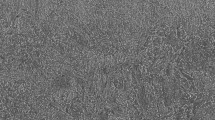Abstract
A study was conducted on the effect of a uniform oxide layer on the galvanizing reaction in 0.20 wt pct Al-Zn and pure Zn baths at 450 °C. In the 0.20 wt pct Al-Zn bath, poor wettability of the oxide layer was observed. No significant liquid Zn penetration of the oxide occurred and, therefore, attack of the steel substrate to form localized Fe-Zn growth did not occur. It was found that the iron oxide acted as a physical barrier or inhibition layer in the pure Zn bath, similar to the Fe2Al5 inhibition layer that forms at the steel interface in Al-Zn baths. The inhibition effect of the oxide in the pure Zn bath was temporary, since cracks and other macrodefects in the oxide acted as fast diffusion paths for Zn. Localized Fe-Zn growth (outbursts) formed at the steel/coating interface, and the number of outbursts was generally inversely proportional to the oxide layer thickness at constant immersion times. Increased immersion time for a constant oxide layer thickness led to an increase in the number of outbursts. These results simulate the diffusion short circuit mechanisms for Fe2Al5 inhibition layer breakdown in Al-containing Zn baths.
Similar content being viewed by others
References
I. Olefjord, W. Leijon, and U. Jelvestam: Appl. Surface Sci., 1980, vol. 6, p. 241.
Y. Hisamatsu: GALVATECH ’89, ISIJ, Tokyo, 1989, p. 3.
J.S. Kirkaldy, and M. Urednicek: Z. Metallkd., 1973, vol. 64, p. 419.
M. Guttmann, Y. Lepretre, A. Aubry, M.-J. Roch, T. Moreau, P. Drillet, J.M. Mataigne, and H. Baudin: GALVATECH ’95, Iron and Steel Society, Warrendale, PA, 1995, p. 295.
C.E. Jordan and A.R. Marder: Metall. Mater. Trans. A, 1994, vol. 25A, pp. 937–47.
J.S. Kirkaldy and M. Urednicek: Metallkd., 1973, vol. 64, p. 899.
N.-Y. Tang and G.R. Adams: The Physical Metallurgy of Zinc Coated Steel, A.R. Marder, ed., TMS, Warrendale, PA, 1994, p. 41.
C.E. Jordan and A.R. Marder: GALVATECH ’95, Iron and Steel Society, Warrendale, PA, 1995, p. 319.
C.E. Jordan, K.M. Goggins, A.O. Benscoter, and A.R. Marder: Mater. Characterization, 1993, vol. 31, p. 107.
L.S. Darken and R.W. Gurry: Physical Chemistry of Metals, McGraw-Hill, New York, NY, 1953, p. 349.
M. Guttmann: Mater. Sci. Forum, 1994, vols. 155–56, p. 527.
Author information
Authors and Affiliations
Rights and permissions
About this article
Cite this article
Jordan, C.E., Marder, A.R. The effect of iron oxide as an inhibition layer on iron-zinc reactions during Hot-Dip galvanizing. Metall Mater Trans B 29, 479–484 (1998). https://doi.org/10.1007/s11663-998-0127-6
Received:
Issue Date:
DOI: https://doi.org/10.1007/s11663-998-0127-6




